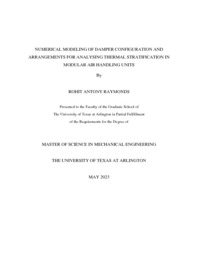
ATTENTION: The works hosted here are being migrated to a new repository that will consolidate resources, improve discoverability, and better show UTA's research impact on the global community. We will update authors as the migration progresses. Please see MavMatrix for more information.
Show simple item record
| dc.contributor.advisor | Agonafer, Dereje | |
| dc.creator | Raymonds, Rohit Antony | |
| dc.date.accessioned | 2023-06-14T17:07:45Z | |
| dc.date.available | 2023-06-14T17:07:45Z | |
| dc.date.created | 2023-05 | |
| dc.date.issued | 2023-05-22 | |
| dc.date.submitted | May 2023 | |
| dc.identifier.uri | http://hdl.handle.net/10106/31284 | |
| dc.description.abstract | Although air handling units are well established and maturated there are opportunities to optimize and improve the overall thermal and flow performance to reduce the carbon footprint of an air-cooled data center. Airside economization (ASE) arrangement to use cold outdoor air to minimize mechanical cooling energy was substantial progress in minimizing the power usage effectiveness (PUE) for data centers. ASE is an arrangement of ducts and dampers with the necessary controls to meet the cooling requirements. Dampers play a significant role in regulating the mass flow rate of the air and in mixing the two air streams: cold outdoor air, and hot return air from the data center to a precondition. The effective mixing of these two air streams is of at most importance to minimize the stratification and improve the performance of the subsequent air conditioning processes such as direct/indirect evaporative cooling. Existing literature investigated the effects of different damper angles on the mixing effectiveness. But the literature lacks a comprehensive characterization and analysis of the damper sizing, configuration, and arrangement and its influence on the flow patterns and air stratification. The literature also lacks to encompass the effects of damper authority in properly matching the dampers to minimize the overall pressure drop. The objective of this article is to analyze the effect of different damper configurations (parallel/opposed blade), damper sizing, and damper matching on the mixing effectiveness of the air streams. A numerical model of dampers in an air handling unit (AHU) was validated using experimental data for the damper characteristics. Numerical modeling is used to parametrically iterate different damper configurations such as parallel flow, counter flow, and a combination of parallel and counter, damper angles. The pressure drop across the dampers and the mixing effectiveness were calculated to have a direct comparison between different damper designs and arrangements. It was observed that certain damper configurations and arrangements yielded higher mixing effectiveness. Opposed blade dampers performed better than parallel blade dampers when matched correctly. This study thereby provides a comprehensive guide for manufacturers to appropriately design AHU factoring in different parameters such as damper combinations and angles to provide optimum thermal and flow performance. | |
| dc.format.mimetype | application/pdf | |
| dc.language.iso | en_US | |
| dc.subject | Data centres | |
| dc.subject | Air cooling | |
| dc.subject | Dampers | |
| dc.subject | Air handling unit | |
| dc.subject | Air mixing effectiveness | |
| dc.subject | Pumping power | |
| dc.title | Numerical modeling of damper configuration and arrangements for analysing thermal stratification in modular air handling units | |
| dc.type | Thesis | |
| dc.date.updated | 2023-06-14T17:07:45Z | |
| thesis.degree.department | Mechanical and Aerospace Engineering | |
| thesis.degree.grantor | The University of Texas at Arlington | |
| thesis.degree.level | Masters | |
| thesis.degree.name | Master of Science in Mechanical Engineering | |
| dc.type.material | text | |
| dc.creator.orcid | 0009-0007-5161-9216 | |
Files in this item
- Name:
- RAYMONDS-THESIS-2023.pdf
- Size:
- 1.790Mb
- Format:
- PDF
This item appears in the following Collection(s)
Show simple item record


